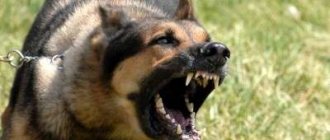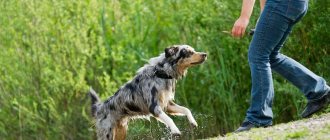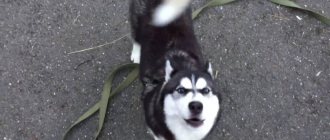Why does a dog run away from its owner?
A properly raised dog must obey its owner unquestioningly and follow all commands. Disobedience can lead to dangerous consequences, for example, running away while walking. Such a problem is fraught with the loss of your four-legged friend; on the street he can get hit by a car or be bitten by other animals. There are several reasons why a pet regularly runs away from its owner:
- fear of punishment, regular abuse;
- banal disobedience - the dog is not trained in the “come to me” command;
- physiological needs, for example, the period of estrus;
- insufficient physical activity.
There are often situations when the owner is not the first owner of the dog or the animal is in foster care. This can lead to the pet trying to escape at any opportunity.
If a dog runs off its leash, it can only return if there is a strong emotional connection with its owner. Thanks to physical endurance, the animal can go quite a long distance, but thanks to marks and familiar smells in its area, the pet can find its way back. However, it is recommended to begin search activities immediately to avoid unpleasant consequences.
Photo: flickr.com
Reproductive instinct
There is a chance that your pet is running away from the backyard in search of a dog of the opposite sex. After the animal is six months old, its reproductive instincts begin to turn on. Male dogs are more likely to leave the house as soon as they smell a female.
How to Wear a Padded Jacket or Chunky Puffer Jacket and Look Effortlessly Cool
US scientists classified people according to their curiosity
GTA 5 for PS5 and Xbox will now run on the RDR2 engine
If the dog runs away while walking
Most often, dogs run away during a walk. This can happen regardless of age, gender or breed. The main reasons why pets run away while walking:
- The owner does not use a leash or tape measure - this is especially dangerous if the animal does not comply with the command “come to me” or “near”. According to the law of the Russian Federation, walking dogs is allowed only on a leash, the length of which allows you to control the pet’s behavior.
- Dogs are sensitive to the mood and emotions of their owner. She may consciously run away if you call her with a threatening intonation, irritation and aggression in your voice.
- Punishing the pet by any means if it nevertheless approaches the leg after escaping. In this case, the animal will form a clear behavioral connection - “punishment for obedience.” This can lead to the pet stopping following commands altogether.
- The dog picks up something and then runs away to avoid punishment. Having a muzzle will help avoid this situation.
- The owner begins to run after the dog if it does not approach on its own. It is best to call her with loud sounds, move calmly and confidently. To attract attention, you can suddenly change the trajectory of your movement, sit down or start jumping.
- The dog's passion for something. It is especially common among hunting breeds and male dogs that have found the trail of a female dog in heat. In this case, you should first draw attention to yourself, and only then call.
- The dog is afraid of his owner. An animal will not want to approach a person who treats it aggressively and regularly punishes it with physical force.
If your four-legged friend does come to you when called, you should not scold or reprimand him, or immediately take him home. The dog develops a bond that the walk ends when he returns. You should also remember about stable physical activity - if the dog does not splash out energy, its obedience and reaction to the owner worsen.
Reasons for running away on the street
While walking the dog, the owner establishes close contact with the pet, teaches useful skills and commands. At the same time, many owners are familiar with the situation when, during a walk, the dog runs home, runs in an unknown direction, absolutely not reacting to the name, commands, or indignant exclamations of the owner.
The main reasons for a dog to run away on the street:
- improper adaptation, socialization;
- errors in education;
- cruel, rude, or improper treatment of a pet;
- spoiled;
- passion, curiosity;
- fear, fright, emotional experience;
- freedom-loving, dominant character;
- predisposition to a free life;
- insufficient duration and activity of walks.
Important! As a rule, puppies up to 5-6 months old do not run away from their owners during walks as often as their adult relatives. According to statistics, the most “lost” dogs are dogs from 8-12 to 15 months. Hyperactive, overly inquisitive dogs, representatives of hunting breeds, and hounds are especially prone to escape.
Most often, hunting dog breeds run away due to their developed instinct. For example, a dog saw a cat or a bird and decided to run after the so-called prey, realizing his potential as a hunter.
Dogs with an easily excitable psyche can also run away from their owner. The dog may become excited when he sees a cyclist, a car, or becomes interested in other dogs or animals on the street. It is possible that the pet was alarmed or frightened by something, so the dog rushed home as fast as he could.
If the dog does not come after being called, perhaps when the dog came, you punished him. Dogs are good at remembering negative actions on the part of their owners, and if a pet runs away or refuses to approach you, it means that it is afraid that it will be punished.
Important! If the dog is guilty, after he approaches you, do not shout, do not hit, do not punish him. You undermine your authority by losing contact with the animal.
If the dog runs towards other dogs, it may be that he lacks communication with his relatives. This behavior can be caused by banal disobedience, ignorance of commands, or insufficient activity.
Dogs often run away during the rut. Instincts dictate, therefore, sensing a bitch in heat, the male will follow her and become uncontrollable. During the period of sexual hunting, not only the hormonal levels of animals change, but also their behavior.
Dogs, in most cases, do not like a leash. After all, it is this attribute that hinders freedom of action. Therefore, when you call your pet to you and plan to finish your walk, do not fasten the leash right away. The dog’s reflex is reinforced: once the owner called and fastened the leash, it means the walk is over and you need to return home. Don't forget that puppies and active young dogs can walk until they get tired or hungry.
If the dog runs away from the yard
In a private home or country house, dogs are often placed outside in an enclosure, on a chain. Even a well-bred and trained animal can run away when exposed to certain external factors. The main reasons why a dog runs away from the site:
- Fear. Pets have a sensitive psyche and are often afraid of sharp sounds - thunder, car horns or pyrotechnic explosions. In such situations, they begin to behave restlessly, which leads to atypical behavior.
- Boredom. For example, if the owner is away from home for a long time. As a rule, this happens with close emotional contact and good socialization of the pet. Escapes often occur due to boredom and with insufficient physical activity.
- Curiosity. The animal may become interested in something outside the yard. It could be a passerby with food or a pleasant smell, a passing cat, or another dog. In such a situation, the pet begins to dig a tunnel and tries to jump over the fence.
To avoid your four-legged friend escaping from the yard, you need to provide maximum protection and isolation from the outside world. Most dogs run away through the fence - they dig under it or jump over it, crawling through holes. It is necessary to ensure reliable protection of the territory and regularly check its integrity.
Most often, representatives of hunting breeds escape (they love to dig, do it efficiently and quickly), as well as large animals capable of high jumps.
Regardless of the size of the breed, it is recommended to tie the dog when you leave home. A securely fastened chain is suitable for this purpose, since the rope can be easily chewed. You should pay attention to the convenience and reliability of the collar - it should fit snugly to the neck and be comfortable for the pet.
The length of the leash should be sufficient for free access to the enclosure or booth, bowls of food, and water. Tangling the legs is strictly prohibited - this method is used only for cattle and horses in the stall.
ADD BRAINS!
So, did you feel like your puppy was running away out of idle curiosity? Now you understand that he is doing important work - learning about the world around him and himself in it in order to become a full-fledged adult dog. After all, it is not enough to have good heredity, it is not enough to belong to a glorious galaxy of certified ancestors - we must make the biological inheritance contained in the genes work. This requires personal experience of encountering the diversity and complexity of the external environment, with its mysteries and dangers. The puppy needs to try and hone his natural abilities in order to develop correctly. You need to experience anxiety and stress, waste energy and get tired.
There was no limit to my amazement when one day, while walking my dog, I met a woman in the park with a 4-month-old husky on a leash. The shepherd wanted to approach the puppy because she loved to play with the “young people.” Seeing this, the woman frantically pulled on the leash and began to retreat, nervously demanding that I take the dog. The owner explained to me that “the puppy is still too small for such games!” Having met this couple six months later, I was not surprised to hear complaints about the dog’s behavior: it ran away from its owner and behaved aggressively when on a leash, although it was afraid of large dogs.
People are willing to pay for a rare breed or for the puppy to come from titled parents. Convinced that the money spent guarantees the “quality” of the dog, they often begin to spoil the precious puppy, not giving it the opportunity to develop properly. It seems that the practice of keeping a dog in an apartment without walking it for up to 4-5 months is already becoming a thing of the past. However, when starting to walk with a 2-3 month old puppy, people overprotect the baby, not allowing him to fully get acquainted with the world: they do not let him off the leash, regulate his relationships with his relatives, or walk in the same place all the time. It is not surprising that the dog seeks to escape such control.
You shouldn’t waste time waiting for the training grounds to start enrolling in obedience schools. You can work with a dog from two months old, and the owner himself is an excellent tool for developing the puppy’s intelligence.
Give food to his mind in the form of educational games with family members, communication with peers and adult dogs, walks along crowded streets and through the forest.
Of course, following this style of relationship with a puppy can waste a lot of time and effort, but it will be a very interesting and creative time! By stimulating and strengthening the puppy’s psyche through interaction with a complex environment, a person can literally “grow” his dog’s brains, which will help him grow resistant to any external influences. Add to this the dog’s complete trust in its owner - after all, he has gone through this difficult path of mastering the world around him. Agree, this is probably what many people dream about when they get a companion dog. petsanimal psychologypetdog psychologypuppy psychology
If the dog runs away from home
In certain circumstances, a dog can easily run away from home. The most common reasons for running away:
- long absence of the owner;
- the presence of an open window, a balcony on the lower floors of the apartment;
- congenital or acquired fearfulness of the pet;
- sharp sounds outside the house;
- the presence of extraneous irritants - odors, animals running nearby, distracting passers-by.
If the dog is in foster care or has a previous owner, the animal may try to run away to find its previous home. If you are adopting an adult pet, it is important to build a good relationship and walk it well. Basic ways to prevent running away from home:
- securely close windows and front doors;
- ensure good physical activity, quality walking of the pet;
- leave a treat so that the animal has something to do;
- if a thunderstorm or fireworks explosions are planned (for the New Year), it is recommended to lock the animal in a small room without windows.
Treats can be hidden around the apartment to keep your pet interested while you are away. Various bones are effective, requiring a lot of time to crack them. After your return, your four-legged friend should always be rewarded for good behavior. Being alone should be taken calmly; the dog must be accustomed to this from puppyhood - left alone in the house, gradually increasing the duration.
How to find a dog?
If the pet does run away, search efforts should begin as early as possible. Useful tips:
- First of all, walk along the usual walking route, looking into all secluded places - basements, trash cans and bushes.
- While searching, take your favorite squeaking toy with you to attract attention with sound.
- Write an ad and post it in the area of the loss. It is best to use bright paper and attach a photo and description of the pet. It is advisable to place it on porches, poles, as well as in the nearest veterinary clinic and pet store.
- Post an ad on social networks, for example, in a thematic group in your city. Offer a reward, but do not indicate its amount (resale may be more profitable than the offered reward).
- If the dog has just run away in an unknown direction, ask passers-by.
- Before entering the house or near the entrance, leave your item with a scent so that it is easier for the dog to find the trail back.
- View video camera recordings in the city - some providers place video surveillance in courtyards, near city attractions and provide access to them for free.
- Call all city shelters, veterinary clinics and crematoriums for animals.
You should approach writing your ad wisely. It is not recommended to indicate all signs - this can protect you from scammers and accurately determine the signs of your pet during a call. You should not indicate the nickname, as this will help the dog adapt faster to its new owners.
Be sure to place an address tag on the collar indicating contact numbers and some emotional phrase, for example, “they are waiting for me at home.” The search for a runaway pet can continue for quite a long time; do not become discouraged if there are no results for a long period. The dog can run very far from home, starting from the second week, the search can begin in nearby cities.
Photo: flickr.com
How to train a dog to stay in the yard
- To begin with, you should tie the animal with a large rope or chain. Here you need to calculate the tension force of the collar. It is necessary that he does not choke the pet, but also does not allow him to get out.
- Next, next to him you need to put the owner’s thing that the dog could recognize, for example, an old bag. Under no circumstances should you leave an item that has been used by another person.
- After this, you need to give the command “sit” and move away five steps.
- Wait three seconds and say “come to me,” then praise your pet after doing it.
- Next, point him to the bag and say “place.” If it doesn't move, then point your pet towards the object.
So, we calmed the pet and gave him the opportunity to understand that he was not abandoned. After that, you can use the following tricks to help make sure your pet stays in the yard.
Robot disinfector and other new products for the post-pandemic world at the exhibition
Hybrid aircraft engines will reduce nitrogen oxide emissions by 95%
What do you do at 109 years old? Zhenya Tsetskhladze takes care of a 2-year-old boy
How to stop a dog from running away
There are several methods to teach a dog not to run away from its owner during a walk in the yard. Basic Rules:
- Teach your pet the “come to me” command. This is recommended to be done in early childhood, when the opportunity arises for walks on the street. You need to call in a joyful and cheerful tone, reinforce the result with treats and encouragement. It is forbidden to scold an animal even if it disobeys. The main goal is to teach how to come to the leg after repeating the command once.
- Designate places on the site where the pet can walk freely. Select a place for the enclosure and insulate it if necessary. Place bowls of water and food nearby.
- From puppyhood, teach the animal to tolerate loneliness. Gradually increase the time when the dog is alone. You can leave the camera at home to monitor behavior.
- When walking, use a comfortable collar; the length of the leash should be sufficient for comfortable movement and your control.
If your dog regularly tries to run away during walks, then you need to take a full course of OKD. This will help teach your pet basic commands; a professional dog trainer will suggest patterns of behavior with a disobedient pet.
Teaching the dog the “Come to me” command
The dog, regardless of breed, must be trained and clearly follow basic commands, such as: “Near”, Fu”, “No”, “Place”, “Come”. Not all dogs make ideal students, especially those with inexperienced owners.
Advice! If you do not have animal training skills, you have your first dog, or your pet is very disobedient, seek help from a dog trainer. The specialist will find an approach to the dog and select the optimal training system.
We teach the dog the “Come to me” command:
- We conduct the first lessons on a long canvas leash. For large dogs, you can also use a strict collar during classes.
- As soon as the pet is a short distance from you, after a few seconds say the pet’s name and give the command in a strict, confident intonation.
- If the dog does not respond, pull the leash towards you.
- You can attract your dog's attention with a treat. As soon as the dog approaches, praise him and give him a treat. Always give your dog different treats. Alternate treats with rewards.
- In the future, replace the treat with praise so that the animal does not constantly associate the call with food.
- Once the dog begins to understand and follow the “come to me” command, begin training without a leash.
- Practice the command in different places and situations.
During your walk, repeat the command “Come to me” several times. Always praise your dog for doing the right thing. When the dog is walking without a leash and runs towards you, give the command “Come to me” several times during the walk.
Do not give a command when your pet is very passionate about something, especially in the first lessons. The dog must be focused on the training process. Attract the dog with a nickname, a treat, pull the leash, and when the dog looks in your direction or walks towards you, say a command in a clear intonation.
Important! The “Come to me” command should not be associated with punishment or something unpleasant for the pet. For example, do not call your dog if you are planning to cut its nails, clean its ears, or perform other hygienic or medical procedures that are not very pleasant for the pet.
Knowing the “Come to me” command, if the dog follows it unquestioningly, you don’t have to worry about the safety of your pet.
Briefly about the main thing
- A dog may run away from its owner during walks, from the yard or directly from the house.
- The main reasons for running away are fear, external stimuli, boredom and lack of physical activity.
- If she lives in the yard, the area needs to be fenced off, and the holes and the presence of tunnels in the ground must be checked.
- If you need to leave your pet alone at home for a long time, it is recommended to leave a treat. Close windows, balconies and doors securely.
- To prevent your friend from escaping, it is important to teach him the “come to me” command and use a leash while walking.
- The search for a runaway dog can take a long time. Ads should be placed in nearby areas on social networks. Regularly go through your pet’s usual route.
Did your dog run away? Share your experience in the comment section on how you taught your pet to return on command.











